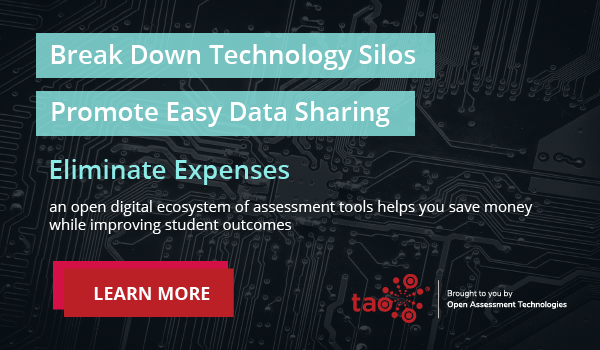When a teacher gives an assessment or a test, the goal is not to simply assign a grade, the goal is to improve teaching and learning. If an assessment is designed effectively and with a high degree of validity and reliability, teachers can use student data to inform future lessons or to identify gaps in student learning. However, it can be challenging for teachers to work with large data sets with many students of many different ability levels.
Although challenges exist with regard to leveraging student data to improve teaching and learning, technology has made this aspect of teaching easier and more efficient. By utilizing technology platforms designed specifically for student assessment, teachers can seamlessly use data in real-time to make big choices in terms of using what students know to determine what to teach next. So, how can educators effectively capture and use student testing data to improve teaching and learning?
Capturing the Data
There are many different methods to consider when determining how to capture testing data effectively. Most importantly, the teacher needs to decide what learning they are assessing. Is the assessment evaluating a base of knowledge? Or is it evaluating a skill or process? Perhaps both? By answering this question, the educator can develop an assessment that fulfills a specific purpose and can allow them to pinpoint areas for growth.
It is also important for educators to consider the limitations of any single test. Rather than over-emphasizing one single assessment, it can be helpful to look at a body of evidence or how the student has progressed in learning over time. Effective data is data that tells a story of student learning, technology has made this easier by allowing for flexibility in test questions and allowing students multiple pathways to success.
What are the Challenges (and how can they be addressed)?
While capturing testing data is important, it also comes with a whole set of challenges that can get in the way of teachers using collecting and utilizing student testing data in an effective way including:
- Developing inclusive testing practices – for a test to accurately reflect a student’s ability, it needs to be designed in a way that all students can access the material and show what they know.
- Working with large data sets – many teachers teach over 100 students, if a test has just 20 questions that means there are 2,000 student responses for teachers to evaluate. A robust, secure, scalable, and organized system in this case is key to effectively managing, safely storing, and analyzing vast amounts of student data.
- Disconnected systems – educators may use a variety of digital tools to assess students, and a lack of integration compatibility can lead to inaccessible data silos and gaps in understanding the whole student. When conducting digital testing, educators should look for a platform built on open standards that enables interoperability with other systems at its core.
- Ensuring that the testing data is valid and reliable – if a teacher is going to use assessment data to improve teaching and learning, they need to have test items that assess what they mean to assess.
What Does Testing Data Reveal About Teaching?
Testing data is good at revealing a ton of information about what students can do but it also can reveal some things about teaching practices themselves. For example, testing data can reveal holes in learning or lesson planning. This is especially true for special education students and language learners. If all students in the class show growth on an exception except for one group, it is a sign that the teacher may need to tweak their lessons to be more inclusive of all students.
What testing data does not reveal, however, are circumstances occurring outside of the classroom. This is why educators need to remember that any single test is just a snapshot, a single data point on the student’s learning journey. Factors such as hunger, depression, or just having a bad day can all impact student test scores. For this reason, educators must provide many opportunities for students to show what they know.
Using Student Assessment Data to Improve Teaching Practices and Strategies
One of the goals of assessing students is to inform instructions, this is why so many schools and teachers are moving towards implementing formative assessments and practices more often. Having many assessments allows educators to change their instruction methods to meet the needs of the students. In general, there are 3 ways that student assessment data can improve teaching and learning.
- Timely data through digital assessment – Delivery of timely and individualized feedback and data is critical, it enables teachers to take what a student knows and build upon that in real-time. Traditionally, a teacher might give an assessment and it would take days or even weeks to have the assessment returned, however, by analyzing student data within a day or two with the help of digital learning platforms, teachers can get data quickly and make changes on the fly.
- Effectively identify areas of student strengths and weakness – Being able to analyze student strengths and weakness is the main goal of assessment. Digital assessment through platforms like Open Assessment Technologies allows educators to pull data based on student answers to group students based on strengths and weaknesses and provide targeted instruction.
- Provide individual support – In the end, all of this allows teachers to give students support at the individual level. By doing this, educators can grow students more effectively based on individual needs and goals.
—
Digital assessments and the ability to look at data in more effective ways have enabled educators to reach students with more intention and to improve teaching and learning. By getting timely data, identifying strengths and weaknesses, and providing individual support, teachers can improve their teaching practices and strategies and improve student growth.
The key to using testing data effectively to improve teaching and learning lies in the learning platform behind data collection and assessment. Platforms like Open Assessment Technologies enable educators to pull large data sets quickly and manipulate the data to individualize instruction. To learn more about how OAT can make analyzing student testing data easy click here.


